Indian spinach
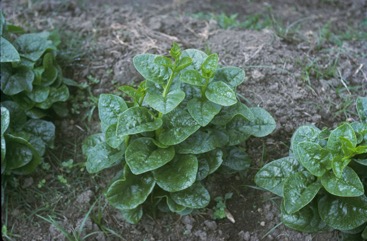
A tropical plant. It occurs mostly in the tropical lowlands and is best below 500 m but will grow up to about 1600 m. in the equatorial tropics. It will grow quite well in the temperature range 15-35°C. It does not like water-logging but can survive 4-12 weeks drought once well established. It requires adequate water during the growing season. It grows well in a variety of soils. The best pH is 5.5-7.0. It cannot tolerate salty conditions. Flowering does not occur when day lengths are over 13 hours. It is found throughout the Philippines in waste places. It can grow in arid places. In XTBG Yunnan.
Also known as:
Adwera, Alogbati, Alugbati, Ama, Aworoke, Bambee, Ban-poi, Basle soppu, Bayam malabar, Boamassaagu, Boroboro, Busum-muru, Caruru, Cejlonska špinača, Ceylon spinach, Chakai, Chan Cai, Chan-Choi, Chra-long, Chunlueng, Chinese callalloo, Delega, Dundula, Enderema, Enderenta, Epinard pays, Espinaca de Malabar, Gandola, Gendola, Genjerot, Ghogboloki, Ginbeik, Inderema, Inika, Inki, Kattupasali, Kurakura, Kurekure, Libato, Luo kui, Maghi, Maifrai, Malabar nightshade, Mayal, Mndele, Mong toi, Mong toi, Mwifrai, Myal-ki-bhaji, Ndelama, Ndelema, Ndera, Nderama, Ndoge, Niviti, Pabang, Pak pang, Pak plang, Pang, Pasalai, Pasali-Kirai, Phakpang, Phak plang, Pichko, Po deng chaai, Poaya, Poi sag, Poi, Poikivel, Poinwel, Poro, Puin, Pui-shak, Rat-nivithi, Remayong, Ronga pui sak, Ronga puroi sak, Saan choi, Shan ts'oi, She eje, Shivappluvaslakkira, Shoro, Sufed-bachla-ki-bhaji, Suped-bachla, Taka ngola, Tembayung, Tsuru-murasaki, Vasalachapu, Vasala dagu, Vine spinach
Synonyms
- Basella cordifolia Lam.
- Basella rubra L.
- Basella lucida L.
Edible Portion
- Leaves, Tender stems, Vegetable
Where does Indian spinach grow?
Found in: Africa, Algeria, Amazon, Andamans, Angola, Asia, Australia, Bahamas, Bangladesh, Benin, Bhutan, Brazil, Burkina Faso, Burundi, Cambodia, Cameroon, Canary Islands, Central Africa, Central African Republic, CAR, China, Congo DR, Cook Islands, Côte d'Ivoire, Cuba, Dominican Republic, East Africa, East Timor, Ethiopia, Fiji, France, Ghana, Guiana, Guianas, Guinea-Bissau, Guyana, Haiti, Hawaii, Himalayas, India, Indochina, Indonesia, Ivory Coast, Jamaica, Japan, Kenya, Kiribati, Laos, Lesser Antilles, Liberia, Madagascar, Malawi, Malaysia, Maldives, Mauritius, Mexico, Mozambique, Myanmar, Namibia, Nepal, Niger, Nigeria, North Africa, North America, Northeastern India, Pacific, Pakistan, Papua New Guinea, PNG, Philippines, Puerto Rico, Rwanda, Sao Tome and Principe, SE Asia, Senegal, Sierra Leone, Singapore, Slovenia, Solomon Islands, South Africa, Southern Africa, South America, Sri Lanka, Sudan, South Sudan, Suriname, Taiwan, Tanzania, Tasmania, Thailand, Timor-Leste, Togo, Tuvalu, Uganda, United States, Vanuatu, Vietnam, West Africa, West Indies, Zambia
Notes: Chemical composition (after Hooper): Water = 92.00% (fresh). Fat = 6.87% (dry). Albumenoids = 20.42% (dry). Carbohydrates = 32.90% (dry). Fibre = 11.55% (dry). Ash = 28.27% (dry). Nitrogen = 3.27% (dry). Phosphoric acid = 1.32% (dry). Silicates = 6.70% (dry). The nutritive value of the leaves and young shoot is very high in terms of minerals and vitamins. It is gently laxative and slightly medicinal.
Status: It is a commercially cultivated vegetable. It has been encouraged and accepted in some coastal areas of Papua New Guinea. Leaves are sold in local markets. It is popular in East Tanzania.
Growing Indian spinach
Cultivation: It can be sown from seeds or cuttings. Seeds germinate in a few days. Normally sticks are provided for support or it is allowed to grow over fences and stumps. If seeds are used, 3 kg of seed will sow one hectare and they are best sown in a nursery and transplanted. A spacing of 1 m is suitable. Plants grown from seed are more productive than from cuttings. When cuttings are used, 20-25 cm long cuttings are suitable. Where the plant grows over light soil it can root at the nodes and continue growing continually. Partial shade, rich fertile soil and adequate moisture favour abundant leaf production. It is responsive to nitrogen fertiliser. Light shade gives bigger leaves. It requires a trellis to climb over. Frequently picking off the bud encourages branching.
Edible Uses: The young shoots and leaves are eaten cooked. They are somewhat slimy. In soups and stews the mucilage can be used as thickening. The purple colour of fruit is harmless and is used to colour vegetables and agar-agar. Some lemon juice added to the dye enhances the colour. The leaves can be eaten raw in salads or cooked like a vegetable. They are also dried and stored. When fresh they can be stored for 4-5 days. The seeds can be crushed to use as an edible dye for jellies. The leaves are used to make tea.
Production: It is 4-6 weeks until the first harvest. It grows reasonably well on poor soils and is fairly resistant to pest and disease. Leaves will only store for one day at 20-30°C. Yields of 40 kg of leaves from a 10 metre square bed is possible over 75 days. Leaves are plucked from the vine.
Nutrition Info
per 100g edible portion| Edible Part | Energy (kcal) | Protein (g) | Iron (mg) | Vitamin A (ug) | Vitamin c (mg) | Zinc (mg) | % Water |
|---|---|---|---|---|---|---|---|
| Leaves | 48 | 5 | 4 | 56 | 100 | - | 85 |
Indian spinach Photos

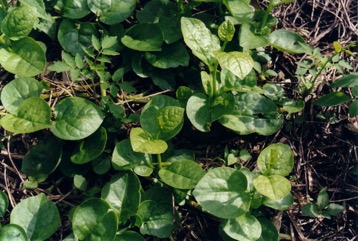
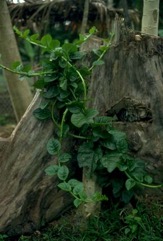
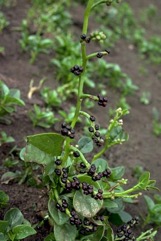
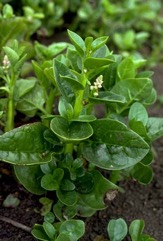
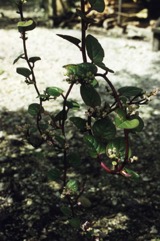
References
Indian spinach references
Abbiw, D.K., 1990, Useful Plants of Ghana. West African uses of wild and cultivated plants. Intermediate Technology Publications and the Royal Botanic Gardens, Kew. p 40
Abukutsa-Onyango, M.O., 2004. Basella alba L. [Internet] Record from Protabase. Grubben, G.J.H. & Denton, O.A. (Editors). PROTA (Plant Resources of Tropical Africa / Ressources végétales de l’Afrique tropicale), Wageningen, Netherlands. < http://database.prota.org/search.htm>. Accessed 14 October 2009.
Achigan-Dako, E, et al (Eds), 2009, Catalogue of Traditional Vegetables in Benin. International Foundation for Science.
Ali, A. M. S., 2005, Homegardens in Smallholder Farming Systems: Examples from Bangladesh. Human Ecology, Vol. 33, No. 2 pp. 245-270
Altschul, S.V.R., 1973, Drugs and Foods from Little-known Plants. Notes in Harvard University Herbaria. Harvard Univ. Press. Massachusetts. no. 938
Ambasta S.P. (Ed.), 2000, The Useful Plants of India. CSIR India. p 68
Anderson, E. F., 1993, Plants and people of the Golden Triangle. Dioscorides Press. p 203
Ara, R. I. T., 2015, Leafy Vegetables in Bangladesh. Photon eBooks. p 17
Arinathan, V., et al, 2007, Wild edibles used by Palliyars of the western Ghats, Tamil Nadu. Indian Journal of Traditional Knowledge. 6(1) pp 163-168
Backer & Bakh. f. 1963-1968. Flora of Java.
Bandyopadhyay, S., et al, 2012, A Census of Wild Edible Plants from Howrah District, West Bengal, India. Proceedings of UGC sponsored National Seminar 2012
Baro, D., Baruah, S. and Borthukar, S. K. 2015, Documentation on wild vegetables of Baksa district, BTAD (Assam). Scholars Research Library. Archives of Applied Science Research, 2015, 7 (9):19-27
Bernholt, H. et al, 2009, Plant species richness and diversity in urban and peri-urban gardens of Niamey, Niger. Agroforestry Systems 77:159-179 (As rubra)
Bircher, A. G. & Bircher, W. H., 2000, Encyclopedia of Fruit Trees and Edible Flowering Plants in Egypt and the Subtropics. AUC Press. p 54 (Also as Basella cordifolia)
Borrell, O.W., 1989, An Annotated Checklist of the Flora of Kairiru Island, New Guinea. Marcellin College, Victoria Australia. p 58
Brouk, B., 1975, Plants Consumed by Man. Academic Press, London. p 139
Brown, W.H., 1941, Useful plants of the Philippines. Department of Agriculture and Natural Resources. Vol 1 Manila.
Brown, W.H., 1920, Wild Food Plants of the Philippines. Bureau of Forestry Bulletin No. 21 Manila. p 56 (As Basella rubra)
Burkill, H. M., 1985, The useful plants of west tropical Africa, Vol. 1. Kew.
Burkill, I.H., 1935, A Dictionary of the Economic Products of the Malay Peninsula. p 251-253
Call, C. A., et al, 2004, Participatory Rural Appraisal in the Upland Ecosystem of Mt Malindang, Misamis Occidental, Philippines. Biodiversity Research Programme for Development in Mindanao.
Chao, Pi-Yu, et al, 2014, Antioxidant Activity in Extracts of 27 Indigenous Taiwanese Vegetables. Nutrients 2014, 6, 2115-2130
Chin, H. F., 1999, Malaysian Vegetables in Colour. Tropical Press. p 13 (As Basella rubra)
Creasy, R., 2000, The Edible Asian Garden. Periplus p 54
Cruz-Garcia, G. S., & Price, L. L., 2011, Ethnobotanical investigation of 'wild' food plants used by rice farmers in Kalasin, Northeast Thailand. Journal of Ethnobiology and Ethnomedicine 7:33 (As Basella rubra)
Dangol, D. R. et al, 2017, Wild Edible Plants in Nepal. Proceedings of 2nd National Workshop on CUAOGR, 2017.
Dansi, A., et al, 2008, Traditional leafy vegetables and their use in the Benin Republic. Genet Resour Crop Evol (2008) 55:1239–1256
Dobriyal, M. J. R. & Dobriyal, R., 2014, Non Wood Forest Produce an Option for Ethnic Food and Nutritional Security in India. Int. J. of Usuf. Mngt. 15(1):17-37
Dutta, U., 2012, Wild Vegetables collected by the local communities from the Churang reserve of BTD, Assam. International Journal of Science and Advanced Technology. Vol. 2(4) p 119
Eilu, G. & Bukenya-Ziraba, R., 2004, Local Use of Climbing Plants of Budongo Forest Reserve, Western Uganda. Journal of Ethnobiology 24(2): 307-327
Encke, F., et al. 1984. Zander: Handworterbuch der Pflanzennamen, ed. 13.
Epenhuijsen C.W. van., 1974, Growing Native vegetables in Nigeria. FAO Rome, p 36
Facciola, S., 1998, Cornucopia 2: a Source Book of Edible Plants. Kampong Publications, p 47
FAO, 1988, Traditional Food Plants, FAO Food and Nutrition Paper 42. FAO Rome p 100
Flora of China. www.eFloras.org
Flora of the Guianas.
Foo, J.T.S.(ed), 1996, A Guide to Common Vegetables. Singapore Science Foundation. p 20 (As Basella rubra)
Fowler, D. G., 2007, Zambian Plants: Their Vernacular Names and Uses. Kew. p 77
French, B.R., 1986, Food Plants of Papua New Guinea, A Compendium. Asia Pacific Science Foundation p 76
French, B.R., 2010, Food Plants of Solomon Islands. A Compendium. Food Plants International Inc. p 102
Global Plants JSTOR
Godfrey, J. et al, 2013, Harvesting, preparationand preservation of commonly consumed wild and semi-wild food plants in Bunyoro-Kitara Kingdom, Uganda. Int. J. Med. Arom. Plants. Vol.3 No.2 pp 262-282
Goode, P., 1989, Edible Plants of Uganda. FAO p 26
Goode, P., 1989, Edible Plants of Uganda. FAO p 39
Gouldstone, S., 1983, Growing your own Food-bearing Plants in Australia. Macmillan p 179 (As Basella rubra)
Grubben, G. J. H. and Denton, O. A. (eds), 2004, Plant Resources of Tropical Africa 2. Vegetables. PROTA, Wageningen, Netherlands. p 103
Hadfield, J., 2001, The A-Z of Vegetable Gardening in South Africa. Struik p 123
Hani Medicine of Xishuangbanna, 1999, p 627 (As Basella rubra)
Hara, H., et al. 1978-1982. An enumeration of the flowering plants of Nepal.
Hara, H., Flora of eastern Himalaya. v. 1:1966, v. 2:1971, v. 3:1975
Harkonen, M. & Vainio-Mattila, K., 1998, Some examples of Natural Products in the Eastern Arc Mountains. Journal of East African Natural History 87:265-278
Hedrick, U.P., 1919, (Ed.), Sturtevant's edible plants of the world. p 93 (As Basella rubra)
Herklots, G. A. C., 1972, Vegetables in South-East Asia. Allen & Unwin. p 152 (As Basella rubra)
Heywood, V.H., Brummitt, R.K., Culham, A., and Seberg, O. 2007, Flowering Plant Families of the World. Royal Botanical Gardens, Kew. p 57 HOOPER,
Hu, Shiu-ying, 2005, Food Plants of China. The Chinese University Press. p 384
Huxley, ed. The new Royal Horticultural Society dictionary of gardening. 1992
Jacquat, C., 1990, Plants from the Markets of Thailand. D.K. Book House p 60
Japanese International Research Centre for Agricultural Science www.jircas.affrc.go.jp/project/value_addition/Vegetables
Jardin, C., 1970, List of Foods Used In Africa, FAO Nutrition Information Document Series No 2.p 58
Johns, T., Mhoro, E. B. and Sanaya, P., 1996, Food Plants and Masticants of the Batemi of Ngorongoro District, Tanzania. Economic Botany, Vol. 50, No. 1, pp. 115-121
Joshi, N., et al, 2007, Traditional neglected vegetables of Nepal: Their sustainable utilization for meeting human needs. Tropentag 2007. Conference on International Agricultural Research for Development.
Joshi, N. & Siwakoti, M., 2012, Wild Vegetables Used by Local Community of Makawanpur District and Their Contribution to Food Security and Income Generation. Nepal Journal of Science and Technology Vol. 13, No. 1 (2012) 59-66
Katz, E., et al, 2012, No greens in the forest? Note on the limited consumption of greens in the Amazon. Acta Soc Bot Pol 81(4):283–293
Kays, S. J., and Dias, J. C. S., 1995, Common Names of Commercially Cultivated Vegetables of the World in 15 languages. Economic Botany, Vol. 49, No. 2, pp. 115-152
Keay & Hepper. 1953-1972. Flora of west tropical Africa, ed. 2.
Kiple, K.F. & Ornelas, K.C., (eds), 2000, The Cambridge World History of Food. CUP p 1807
Knott, J.E. & Deanon, J.R., Vegetable Production in South East Asia. University of the Philippines. 1967. p 273-276.
Kumar, A., 2013, Ethnobotanical study of wild vegetables used by rural communities of Kannauj district, Uttar Pradesh, India. Emir. J. Food Agric. 2013. 25 (10): 760-766
Kumar, S. A., Manus, D. & Mallika, M., 2018, Impact of non-timber forest products on Forest and in Livelihood Economy of the People of Adjoining Areas of Jalpaiguri Forest Division, West Bengal, India. Int. J. of Life Sciences, 2018; 6 (2):365-385
Kunkel, G., Plants for human consumption
Kuo, W. H. J., (Ed.) Taiwan's Ethnobotanical Database (1900-2000), http://tk.agron.ntu.edu.tw/ethnobot/DB1.htm
Latham, P., 2004, Useful Plants of Bas-Congo province. Latham & DFID p 48
Latham, P. & Mbuta, A. K., 2014, Useful Plants of Bas-Congo Province, Democratic Republic of Congo. Volume 1. Salvation Army. p 71
Lautenschläger, T., et al, 2018, First large-scale ethnobotanical survey in the province of Uíge, northern Angola. Journal of Ethnobiology and Ethnomedicine (2018) 14:51
Leon,J., 1968, Fundamentos Botanicos de Los Cultivos Tropicales p 389
Liberty Hyde Bailey Hortorium. 1976. Hortus third.
Lu De-quan, BASELLACEAE [Draft], Flora of China
Lugod, G.C. and de Padua L.S., 1979, Wild Food Plants in the Philippines. Vol. 1. Univ. of Philippines Los Banos. p 21
Lugod, G.C. and de Padua L.S., 1979, Wild Food Plants in the Philippines. Vol. 1. Univ. of Philippines Los Banos. p 21 (As Basella rubra)
Lyimo, M., et al, 2003, Identification and nutrient composition of indigenous vegetables of Tanzania. Plant Foods for Human Nutrition. 58: 85-92
Macbr., J. F., et al., eds. 1936-1971; new ser. 1980-. Flora of Peru.
Macmillan, H.F. (Revised Barlow, H.S., et al) 1991, Tropical Planting and Gardening. Sixth edition. Malayan Nature Society. Kuala Lumpur. p 343
Malaisse, F., 2010, How to live and survive in Zambezian open forest (Miombo Ecoregion). Les Presses Agronomiques de Gembloux.
Manandhar, N.P., 2002, Plants and People of Nepal. Timber Press. Portland, Oregon. p 105
Marandi, R. R. & Britto, S. J., 2015, Medicinal Properties of Edible Weeds of Crop Fields and Wild plants Eaten by Oraon Tribals of Latehar District, Jharkhand. International Journal of Life Science and Pharma Research. Vo. 5. (2) April 2015
Marshall, F., Agriculture and Use of Wild and Weedy Greens by the Piik ap Oom Okiek of Kenya. Economic Botany, Vo. 55, No. 1, pp. 32-47
Martin, F.W., & Ruberte, R.M., 1975, Edible Leaves of the Tropics. Antillian College Press, Mayaguez, Puerto Rico. p 25
Maundu, P. et al, 1999, Traditional Food Plants of Kenya. National Museum of Kenya. p 73
Medhi, P. & Borthakur, S. K., 2012, Phytoresources from North Cachur Hills of Assam -3: Edible plants sold at Hflong market. Indian Journal or Natural Products and Resources. 3(1) pp 84-109
Miguel, E., et al, 1989, A checklist of the cultivated plants of Cuba. Kulturpflanze 37. 1989, 211-357
Monsalud, M.R., Tongacan, A.L., Lopez, F.R., & Lagrimas, M.Q., 1966, Edible Wild Plants in Philippine Forests. Philippine Journal of Science. p 445
Mot So Rau Dai an Duoc O Vietnam. Wild edible Vegetables. Ha Noi 1994, p 124 (As Basella rubra)
Msuya, T. S., et al, 2010, Availability, Preference and Consumption of Indigenous Foods in the Eastern Arc Mountains, Tanzania, Ecology of Food and Nutrition, 49:3, 208-227
Narayanan Ratheesh, M. K. et al, 2011, Wild edible plants used by the Kattunaikka, Paniya and Kuruma tribes of Wayanad District, Kerala, India. Journal of Medicinal Plants Research Vol. 5(15), pp. 3520-3529
Narzary, H., et al, 2013, Wild Edible Vegetables Consumed by Bodo tribe of Kokrajhar District (Assam), North-East India. Archives of Applied Science Research, 5(5): 182-190
Norrington, L., & Campbell, C., 2001, Tropical Food Gardens. Bloomings Books. p 51
Neal, C.M.,1965, In Gardens of Hawaii. p343 Bishop Museum Press.
Nyadanu, D., et al, 2015, Agro-biodiversity and challenges of on-farm conservation: the case of plant genetic resources of neglected and underutilized crop species in Ghana. Genet. Resourc. Crop Evol. 62(7):
Nzigidahera, B., 2006, Assessment of Socio-cultural, Economic Characteristics and Livelihood of Riparian Population of the Kibira National Park. (Rukoma-Mutana locality). UNDP p 30
Ochse, J.J. et al, 1931, Vegetables of the Dutch East Indies. Asher reprint. p 75 (As Basella rubra)
Ojelel, S., et al, 2019, Wild edible plants used by communities in and around selected forest reserves of Teso-Karamoja region, Uganda. Journal of Ethnobiology and Ethnomedicine (2019) 15:3
Ogle, B. M., et al, 2003, Food, Feed or Medicine: The Multiple Functions of Edible Wild Plants in Vietnam. Economic Botany 57(1): 103-117 (As Basella rubra)
Omawale, 1973, Guyana's edible plants. Guyana University, Georgetown p 101
Omawale, 1973, Guyana's edible plants. Guyana University, Georgetown p 101 (As Basella rubra)
Oomen, H.A.P.C., & Grubben, G.J.H., 1978, Tropical Leaf Vegetables in Human Nutrition, Communication 69, Department of Agricultural research, RTI Amsterdam, p 26, 36, 66, 81
Patiri, B. & Borah, A., 2007, Wild Edible Plants of Assam. Geethaki Publishers. p 112
Pham-Hoang Ho, 1999, An Illustrated Flora of Vietnam. Nha Xuat Ban Tre. p 735 (As Basella rubra)
Phon, P., 2000, Plants used in Cambodia. © Pauline Dy Phon, Phnom Penh, Cambodia. p 89
Plants of Haiti Smithsonian Institute http://botany.si.edu
Pradhan, R., et al, 2020, Potential Wild Edible Plants and its Significance in Livelihood of Indigenous People of Male Mahadeshwara Hills, Karnataka. Economic Affairs Vol. 64, No. 4 pp. 01-14
Prafulla, S., 2017, Wild Food Diversity of Nawegaon-Nagzira Tiger Reserve in Gondia-Bhandara district of Maharashtra, India. Int. J. of Life Sciences, 2017, Vol. 5 (4): 620-626
Purseglove, J.W., 1968, Tropical Crops Dicotyledons, Longmans. p 628
Royal Botanic Gardens, Kew (1999). Survey of Economic Plants for Arid and Semi-Arid Lands (SEPASAL) database. Published on the Internet; http://www.rbgkew.org.uk/ceb/sepasal/internet [Accessed 4th April 2011]
Sarvalingam, A., et al, 2014, Wild edible plant resources used by the Irulas of the Maruthamalai Hills, Southern Western Ghats, Coimbatore, Tamil Nadu. Indian Journal of Natural Products and Resources 5(2):198-201
Schneider, E., 2001, Vegetables from Amaranth to Zucchini: The essential reference. HarperCollins. p 26
Rajapaksha, U., 1998, Traditional Food Plants in Sri Lanka. HARTI, Sri Lanka. p 94
Rajasab, A. H. & Isaq, M., 2004, Documentation of folk knowledge on edible wild plants of North Karnataka. Indian Journal of Traditional Knowledge 3(4) pp 419-429
Rashid, H. E., 1977, Geography of Bangladesh. Westview. p 281 (As Basella rubra)
Rasingam, L., 2012, Ethnobotanical studies on the wild edible plants of Irula tribes of Pillur Valley, Coimbatore district, Tamil Nadu, India. Asian Pacific Journal of Tropical Biomedicine. (2012) S1493-S1497
Recher, P, 2001, Fruit Spirit Botanical Gardens Plant Index. www.nrg.com.au/~recher/ seedlist.html p 1
Rehm, S., & G. Espig. 1991. The cultivated plants of the tropics and subtropics.
Rubaihayo, E. B., Conservation and use of traditional vegetables in Uganda. Bioversity International.
Segnon, A. C. & Achigan-Dako, E. G., 2014, Comparative analysis of diversity and utilization of edible plants in arid and semi-arid areas in Benin. Journal of Ethnobiology and Ethnomedicine 2014, 10:80
Seidemann J., 2005, World Spice Plants. Economic Usage, Botany, Taxonomy. Springer. p 63
Shah, G.L., 1984, Some economically important plant of Salsette Island near Bombay. J. Econ. Tax. Bot. Vol. 5 No. 4 pp 753-765 (As Basella rubra)
Shah, S. K., 2014, Dietary contribution of underutilized minor crops and indigenous plants collected from uncultivated lands and forests in Nepal. in Promotion of Underutilized Indigenous Food Resources for Food Security and Nutrition in Asia and Pacific. FAO. Bangkok p 64 (As Basella rubra)
Sharma, B.B., 2005, Growing fruits and vegetables. Publications Division. Ministry of Information and broadcasting. India. p 195 (As Basella rubra)
Siemonsma, J. S. and Piluek, K. (Eds), 1994, Plant Resources of South-East Asia No. 8 Vegetables. Prosea Foundation, Bogor, Indonesia, p 93
Singh, A. G., et al, 2012, Wild Plants Used as Vegetable in Rupandehi District of Nepal and Their Ethnomedicinal Importance. J. Nat. Hist. Mus. Vol. 26, 2012, 111-125
Smith, A.C., 1981, Flora Vitiensis Nova, Lawaii, Kuai, Hawaii, Volume 2 p 280
Smith, K., 1998. Growing Uncommon Fruits and Vegetables. New Holland. p 47
Sp. pl. 1:272. 1753
Srichaiwong, P., et al, 2014, A Study of the Biodiversity of Natural Food Production to Support Community Upstream of Chi Basin, Thailand. Asian Social Science 10 (2):
Staples, G.W. and Herbst, D.R., 2005, A tropical Garden Flora. Bishop Museum Press, Honolulu, Hawaii. p 173 (Drawing)
Steenis, C.G.G.J., van, ed. 1948-. Flora malesiana. p 300-302
Sujanapal, P., & Sankaran, K. V., 2016, Common Plants of Maldives. FAO & Kerala FRI, p 53
Sukarya, D. G., (Ed.) 2013, 3,500 Plant Species of the Botanic Gardens of Indonesia. LIPI p 1067
Tanaka, Y. & Van Ke, N., 2007, Edible Wild Plants of Vietnam: The bountiful garden. Orchid books. p 51
Terashima, H., et al, 1991, Ethnobotany of the Lega in the tropical rainforest of eastern Zaire: part 1, Zone de Mwenga. African Study Monographs. Suppl. 15:1-61
Terra, G.J.A., 1973, Tropical Vegetables. Communication 54e Royal Tropical Institute, Amsterdam, p 27
Terra, G.J.A., 1973, Tropical Vegetables. Communication 54e Royal Tropical Institute, Amsterdam, p 27, 28 (As Basella rubra)
Terrell et al. 1986. Agric. Handb. no. 505.
Thaman, R. R, 2016, The flora of Tuvalu. Atoll Research Bulletin No. 611. Smithsonian Institute p 71
Thitiprasert, W., et al, 2007, Country report on the State of Plant Genetic Resources for Food and Agriculture in Thailand (1997-2004). FAO p 95 (As Basella rubra)
Tindall, H.D., & Williams, J.T., 1977, Tropical Vegetables and their Genetic Resources, International Board for Plant Genetic Resources, Rome, p 97
Tindall, H.D., 1968, Commercial Vegetable Growing. Oxford Tropical Handbooks p 224
Tindall, H.D., 1983, Vegetables in the tropics. Macmillan p. 67
Turrill et al., eds. 1952-. Flora of tropical East Africa.
Tutin et al., eds. 1964-1980. Flora europaea.
UPHOF
Uprety, Y., et al, 2016, Traditional use and management of NTFPs in Kangchenjunga Landscape: implications for conservation and livelihoods. Journal of Ethnobiology and Ethnomedicine (2016) 12:19
USDA, ARS, National Genetic Resources Program. Germplasm Resources Information Network - (GRIN). [Online Database] National Germplasm Resources Laboratory, Beltsville, Maryland. Available: www.ars-grin.gov/cgi-bin/npgs/html/econ.pl (10 April 2000)
Van Sam, H. et al, 2008, Uses and Conservation of Plant Species in a National Park. A case study of Ben En, Vietnam. Economic Botany 62:574-593
van Wyk, B., 2005, Food Plants of the World. An illustrated guide. Timber press. p 84
von Katja Rembold, 2011, Conservation status of the vascular plants in East African rain forests. Dissertation Universitat Koblenz-Landau p 159
Walker, E., 1976. Flora of Okinawa and the southern Ryukyu Islands.
Williamson, J., 2005, Useful Plants of Malawi. 3rd. Edition. Mdadzi Book Trust. p 34
Winters, H., F., Ceylon Spinach (Basella rubra ). Economic Botany
Woodson & Schery, eds. 1943-1980. Flora of Panama.
Woodward, P., 2000, Asian Herbs and Vegetables. Hyland House. p 28
World Checklist of Useful Plant Species 2020. Royal Botanic Gardens, Kew
www.eFloras.org Flora of China
Xu, You-Kai, et al, 2004, Wild Vegetable Resources and Market Survey in Xishuangbanna, Southwest China. Economic Botany. 58(4): 647-667.
Yamada, T., 1999, A report of the Ethnobotany of the Nyindu in the Eastern part of the former Zaire. African Study Monographs 20(1):1-72
Zon, A.P.M. van der, Grubben, G.J.H., 1976, Les legumes-feuilles spontanes et cultives du Sud-Dahomey, Communication 65, Royal Tropical Institute, Amsterdam, p 35, 36